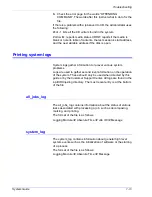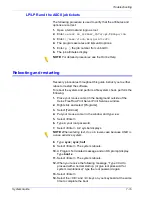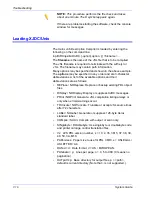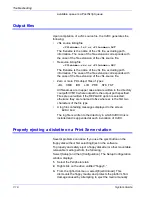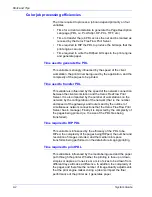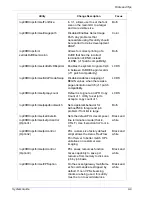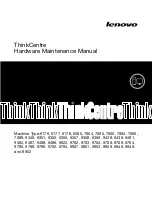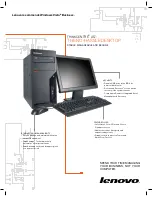
System Guide
8- 5
Hints and Tips
being used (i.e. lpr, IPP, SNMP, HTTP, Novell, Appletalk or Token
Ring), keeping only those that are needed.
Job submission order
Job submission order can impact performance. It is suggested
that a job with many pages to be RIPped and a large number of
copies should be submitted at the end of the day if possible. With
the printer paused, the job can then RIP over night. The job then
starts printing at the beginning of the next day and while it is
printing, the Xerox FreeFlow Print Server can process a complex/
difficult job that takes a long time to RIP. As long as the previous
job is still printing when the next job finishes RIPing, the Print
Server can RIP still another job to get even further ahead. In this
way, the print engine itself is never idle waiting for a hard job to
finish RIP.
Job RIP hints
If using the default media/color settings that are pre-loaded on the
controller, the Xerox FreeFlow Print Server process built in color
space transformations to accelerate RIP performance. If you do
any of the following, the color space transformation probably takes
more time and the RIP is slower:
•
Define own media
•
Include input or output ICC color profiles in the PDL file
•
Change any of the system color settings (that is, saturation,
lightness, color adjustments for C,M,Y or K, emulation mode,
etc.)
NOTE: In general, RGB and LAB color space transformations are
slower than CMYK transformations. If the input images of a job
can be created in CMYK color space, then the Xerox FreeFlow
Print Server are able to process the job more efficiently.
Variable data
Variable data job construction is also an important driver of RIP
performance. Jobs that are constructed with a single underlay or
background plane and a small number of variable text or image
overlays run very efficiently. If the same job is constructed with the
underlay constructed from several distinct objects which the Xerox
FreeFlow Print Server is asked to compose on the fly, then the job
is not able to take advantage of the Print Server variable data
performance enhancement. In that case, the job may RIP
significantly slower than the more efficiently constructed job.
For cases where the background/underlay of the variable data job
is composed of 2 or 3 relatively static objects, it is suggested to
have the application create each static combination of objects as a
different underlay. This is more efficient than having the Xerox
FreeFlow Print Server perform the composition. When creating
Summary of Contents for FREEFLOW 701P25032
Page 1: ...Print Server version 6 0 April 2007 Xerox FreeFlow Print Server System Guide 701P25032...
Page 26: ...1 18 System Guide Gateway and Network Configuration...
Page 36: ...2 10 System Guide Backup and Restore...
Page 78: ...6 12 System Guide Accounting and Billing...
Page 98: ...7 20 System Guide Troubleshooting...
Page 110: ...8 12 System Guide Hints and Tips...
Page 111: ......
Page 112: ......



